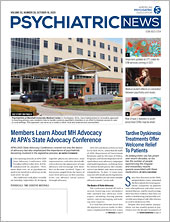At the end of June, the Centers for Disease Control and Prevention (CDC) surveyed Americans to determine the impact of the COVID-19 pandemic on their mental health. The survey revealed that a quarter of respondents aged 18 to 24 had seriously considered suicide in the past 30 days (
Psychiatric News).
The pandemic may exacerbate an existing crisis within the country: youth suicide. The rate of suicide among adolescents and young adults aged 10 to 24 increased by 57.4% between 2007 and 2018, according to a CDC report issued last month.
Child and adolescent psychiatrists have been working on ways to address this disturbing trend, which has also been evidenced in rates among Black youth (see
Psychiatric News), said Gabrielle Shapiro, M.D., chair of APA’s Council on Children, Adolescents, and Their Families. “A major obstacle has been the contagion of media romanticization of suicide,” she said. Additionally, widespread use of platforms such as Instagram, Snapchat, TikTok, and Twitter, among others, has led to increased concerns that cyberbullying may be precipitating some of the suicidal behaviors.
“Overall, young people are, at times, very impulsive, and they may be suffering from untreated mental illness,” said Tresha Gibbs, M.D., a member of APA’s Council on Children, Adolescents, and Their Families. “We know that a lot of young people who need care are not getting it.”
Feeling hopeless, Gibbs said, likely plays a role in the increasing rate, as well. “Many populations do not feel they are experiencing the American dream right now. We can’t get away from the fact that there is just so much inequality in the U.S. that it creates this extra stress—the stress of poverty and the stress of lack of opportunities.”
According to the CDC, the states with the highest rates of adolescent and young adult suicide from 2016 to 2018 were concentrated in the West, including Montana, New Mexico, South Dakota, and Wyoming. States with the lowest rates were largely in the Northeast, including Connecticut, Massachusetts, New Jersey, New York, and Rhode Island.
Gibbs hypothesized that stricter gun laws in the Northeast may provide some explanation as to why rates of suicide were lower there compared with the rest of the country. “At the end of the day, we need to do more to decrease access to lethal means,” she said. She added that access to lethal medications and substances is also an area of concern. “You start to wonder: How long is it going to take our society to take drastic steps to protect young people from hurting themselves?”
She pointed to interventions such as increased screening and early identification of at-risk youth, community crisis support, and culturally sensitive treatment to reduce suicide among youth.
“Our society, as well as the entire world, has been traumatized by the COVID-19 pandemic,” Shapiro said. More people are experiencing symptoms of stress and trauma. “Focused and informed treatment for individuals and groups through integrated programs in schools and communities would be a great method to try to assist Americans and minimize the long-term impact of the pandemic.”
Shapiro noted that the APA Foundation’s Notice. Talk. Act. at School program is an excellent resource for school personnel who interact with children in their communities.
Pervasive negative attitudes and lack of knowledge about mental illness are obstacles to preventing the death of children and adolescents by suicide. “We must erase the stigma to save these young lives,” Shapiro said. ■
“State Suicide Rates Among Adolescents and Young Adults Aged 10-24: United States, 2000-2018” is posted
here.

